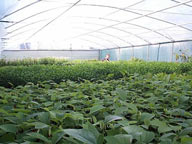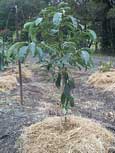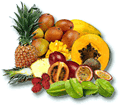July 2002
The Daley News
Featuring:
What's New
The Nursery
The Orchard
Fruit Tree of the Month
Rainforest, Dryland Native and Hedge Plants
Feature article
What's New - Our new website
How have you found our new website? We would love any critical comments so we can make it more user friendly for you. We have had a very busy year and have sold out of a lot of stock until the spring brings our new seasons stock along again. Our available stock list is always in the shopping trolley or a work document can be downloaded by going to https://www.daleysfruit.com.au/Howtoorder.htm
The Nursery
 With winter comes the relocation of all the subtropical plants into our new huge polyhouses that Rick and Rodney built over the warmer months. The warm environment of the polyhouses enables the plants to recover much fast after the cold weather has passed. This means we can get them to you earlier in the spring. All this adds up to faster established gardens.
With winter comes the relocation of all the subtropical plants into our new huge polyhouses that Rick and Rodney built over the warmer months. The warm environment of the polyhouses enables the plants to recover much fast after the cold weather has passed. This means we can get them to you earlier in the spring. All this adds up to faster established gardens.
The Orchard
This month we have masses of Avocadoes, Custard Apples and Cherimoya coming off the trees. The citrus trees are weighed down with the weight of fruits that include limes, lemons and mid-season oranges. We are starting to see the beginning of the blueberries especially the Sharpeblue.
Fruit Tree of the Month
AVOCADO
Avocadoes are one of our most loved and versatile fruits. Of the many varieties available Hass and Fuerte are the most common and popular followed by the other varieties like Sharwil, Sheppard and Pinkerton.
Our recommended varieties …
 The Hass originated from a seed planted by, you guessed it - Mr R G Hass. It proved to be a vigorous grower and in an orchard variety is bears heavily and uniformly. (planted as a single tree it can tend towards alternate bearing). The fruits are green, turning dark on tree and black when ripe. The skin of the Hass has a pebbly leathery texture. The flesh is creamy, the keeping qualities are good and most importantly the flavour is excellent.
The Hass originated from a seed planted by, you guessed it - Mr R G Hass. It proved to be a vigorous grower and in an orchard variety is bears heavily and uniformly. (planted as a single tree it can tend towards alternate bearing). The fruits are green, turning dark on tree and black when ripe. The skin of the Hass has a pebbly leathery texture. The flesh is creamy, the keeping qualities are good and most importantly the flavour is excellent.
The Fuerte is an excellent variety introduced into California before heading to Australia to represent over 40% of our commercial crop. Quite different to the Hass in appearance the Fuerte has a thin leathery skin and remains a dark glossy green when ripe. Fuerte are a popular choice for gardeners in marginal and cooler areas due to its higher cold tolerance, however the warmer the climate the more productive the tree.
The Shepard, another variety introduced by a man of the same name. It is a small to medium pear-shaped fruit with thick, green skin that peels easily. The fruit has an excellent flavour and is said to have a higher resistance to frost than some other varieties but again the better the conditions the better the performance. The flavour of the Shepard is excellent and the keeping quality is good. The tree is somewhat short lived in comparison with the Fuerte and Hass performing well to around 7-8 years.
The Sharwil is a sentimental favourite as it was introduced in 1954 in Redland Bay, Queensland. The fruit is more rounded than the Fuerte with green skin of a medium thickness. For those with limited space the Sharwil is a good choice due to its slightly dwarfing characteristics. The creamy flesh has an exquisite nutty flavour which is responsible for the Sharwil being known as the gourmet avocado.
 The Pinkerton again named after its founder is a medium to large fruit which is favoured due to its skin being peeled easily, the seed is easily separated from the flesh and it has smooth, buttery and fibreless flesh. Although considered one of the leading commercial varieties it is still just behind the Hass and Fuerte. One reason for this is due to its long neck which is considered a disadvantage when packing. The tree is medium to large, spreading and very vigorous. It bears heavily but can be prone to cold damage.
The Pinkerton again named after its founder is a medium to large fruit which is favoured due to its skin being peeled easily, the seed is easily separated from the flesh and it has smooth, buttery and fibreless flesh. Although considered one of the leading commercial varieties it is still just behind the Hass and Fuerte. One reason for this is due to its long neck which is considered a disadvantage when packing. The tree is medium to large, spreading and very vigorous. It bears heavily but can be prone to cold damage.
How to grow the best avocadoes ….
 Avocadoes need a warm sunny position. They are suited only to frost free areas that are well sheltered from strong winds. Well drained soil is essential, preferably to a depth of 1m. At planting make sure to protect the young tree from wind, sunburn and frost by placing a tree guard around the newly planted tree. Alternatively several wattle branches pushed into the ground can give the much needed initial protection. Mulching is also a priority, as the roots of the avocado love feeding on the decomposing organic matter that a good mulch can offer. Once established in the right situation you will not get a more productive and usefull tree in the orchard.
Avocadoes need a warm sunny position. They are suited only to frost free areas that are well sheltered from strong winds. Well drained soil is essential, preferably to a depth of 1m. At planting make sure to protect the young tree from wind, sunburn and frost by placing a tree guard around the newly planted tree. Alternatively several wattle branches pushed into the ground can give the much needed initial protection. Mulching is also a priority, as the roots of the avocado love feeding on the decomposing organic matter that a good mulch can offer. Once established in the right situation you will not get a more productive and usefull tree in the orchard.
When to harvest …
Grafted trees that have been well cared for usually begin to bear fruit in the third year after planting. It can be a challenge determining the best time to harvest with different varieties having varying characteristics, such as dark skin or glossy green skin when ripe. Some varieties differ again with their ripeness being indicated by a slight tinge of yellow under the fruit stalk.
When purchasing your Avocado take advantage of our knowledge and ask for the ripening characteristics. Alternatively follow these basic steps:
Be aware of the time of cropping for your chosen variety.
Know the expected fruit size and weight at maturity.
Look for a dulling on the skin surface.
Harvest one of the largest fruit first. If it's mature it will ripen at room temperature within 8 to 10 days. Take heart harvesting is a skill that can be easily learnt.
Take care never to pull avocadoes from the tree as this can lead to disease and stem damage. Cut the fruit from the tree with secateurs leaving a short stub on the stalk. Although hard, handle the fruit carefully as it can and will bruise.
We highly recommend that where room allows plant avocadoes with compatible varieties. By planting more than one type you can increase the yield substantially and extend the harvest period.
Kwai Muk
The Kwai Muk is native to China. It is a slow-growing, slender tree that can be grown as an ornamental specimen plant due to its erect growing habit and attractive long slender leaves.
The round fruits have a velvety, brownish, thin, tender skin. When mature the pulp is orange-red to red, soft, acid to subacid and of an excellent flavour. The fruit can be seedless or may contain 1 to 7 small pale seeds. The pulp is delicious eaten raw or can be preserved or sundried. Ripens from February to April.
The trees are not as cold tolerant as initially thought and are injured by brief drops in temperature to -2°C. Mature trees have endured -4°C which is similar to a mango or jakfruit.
Rainforest, Dryland Native and Hedge Plants
FLAME TREE (Brachychiton acerifolius) This spectacular tree can be seen on  hillsides as a striking red glow against the green canopy in early spring. The flowers are shaped like delicate red bells and are followed by thick black pods. The tree is partially deciduous, dropping its leaves just prior to flowering. A conical shaped tree, the base of the trunk is brown and the upper trunk is green.
hillsides as a striking red glow against the green canopy in early spring. The flowers are shaped like delicate red bells and are followed by thick black pods. The tree is partially deciduous, dropping its leaves just prior to flowering. A conical shaped tree, the base of the trunk is brown and the upper trunk is green.
The flame tree makes an excellent companion to the Jacaranda tree. With both tree flowering at the same time they make a spectacular display of colour.






